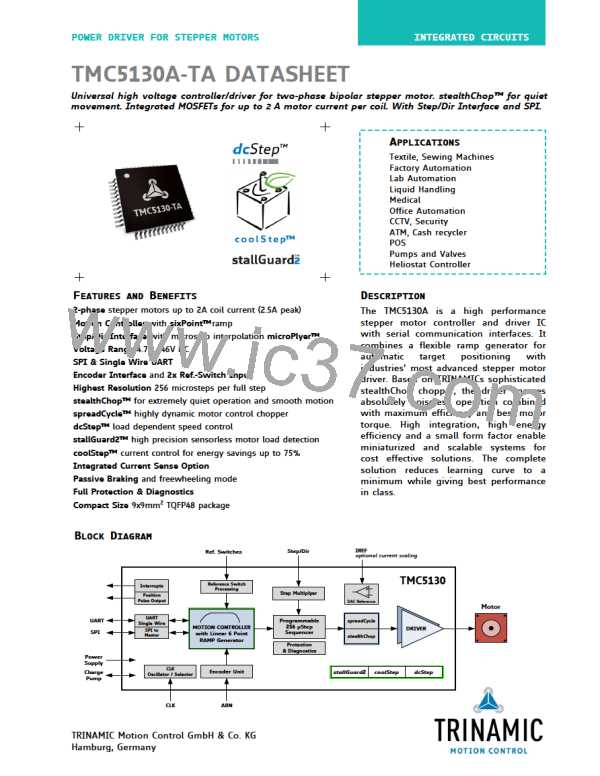TMC5130A DATASHEET (Rev. 1.14 / 2017-MAY-15)
57
Hint
In case the automatic scaling regulation is instable at your desired motion velocity, try modifying the
chopper frequency divider PWM_FREQ. Also adapt the blank time TBL and motor current for best
result.
7.5 Flags in stealthChop
As stealthChop uses voltage mode driving, status flags based on current measurement respond
slower, respectively the driver reacts delayed to sudden changes of back EMF, like on a motor stall.
A motor stall can lead to an overcurrent condition. Depending on the previous motor velocity, and on
the coil resistance of the motor, it may trigger the overcurrent detection. With low velocities, where
the back EMF is just a fraction of the supply voltage, there is no danger of triggering the short
detection.
7.5.1 Open Load Flags
In stealthChop mode, status information is different from the cycle-by-cycle regulated chopper modes.
OLA and OLB show if the current regulation sees that the nominal current can be reached on both
coils.
-
A flickering OLA or OLB can result from asymmetries in the sense resistors or in the motor
coils.
-
-
An interrupted motor coil leads to a continuously active open load flag for the coil.
One or both flags are active, if the current regulation did not succeed in scaling up to the full
target current within the last few fullsteps (because no motor is attached or a high velocity
exceeds the PWM limit).
If desired, do an on-demand open load test using the spreadCycle chopper, as it delivers the safest
result. With stealthChop, PWM_SCALE can be checked to detect the correct coil resistance.
7.5.2 PWM_SCALE Informs about the Motor State
Information about the motor state is available with automatic scaling by reading out PWM_SCALE. As
this parameter reflects the actual voltage required to drive the target current into the motor, it
depends on several factors: motor load, coil resistance, supply voltage, and current setting. Therefore,
an evaluation of the PWM_SCALE value allows seeing the motor load (similar to stallGuard2) and
finding out if the target current can be reached. It even gives an idea on the motor temperature
(evaluate at a well-known state of operation).
www.trinamic.com

 TRINAMIC [ TRINAMIC MOTION CONTROL GMBH & CO. KG. ]
TRINAMIC [ TRINAMIC MOTION CONTROL GMBH & CO. KG. ]